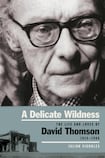
It was Seamus Heaney who described David Thomson as having had about him "a delicate wildness", the title Julian Vignoles has chosen for his biography of the writer, and Heaney who wrote the poem in memory of Thomson with which Vignoles prefaces the book. In The Spring a hare confounds the person following her tracks in snow, springing, weaving, dodging, "haring it out until the very end". The hare, Heaney noted, was the animal Thomson regarded as his totem: "shy, vivid, and capable of swift epiphanies".
Although he does quote from Heaney's wonderful introduction to Thomson's early, marvellous book The People of the Sea, Vignoles does not quote Heaney's astute commentary on the difficulty of writing about Thomson. The book is about journeying along the west coasts of Ireland and Scotland in search of seal legends. "Analysis and appreciation feel superfluous," wrote Heaney. "Commentary seems to lead in the wrong direction." The book was "luminously its own thing".
Thomson's best-known book is Woodbrook, first published in 1973 and still in print 42 years later. He was in his early 50s when he set out to write it, and married to Martina. He had written a series of books for children, about the adventures of Danny Fox, charming stories he developed while telling them to their own boys. He worked for the BBC, making strikingly original radio documentaries.
He was also in precarious mental health, with a drinking habit that his doctor described as a problem and that Thomson – who was prone to states of mania that led, with increasing frequency, to his being hospitalised – described as a blessing. Vignoles describes a chance meeting Thomson had in a London psychiatric hospital with an Irish student nurse called Mary Pogue, who turned out to be the daughter of a postman Thomson had come to know in Ireland in the early 1930s, when he was employed as a tutor during the long holidays from Oxford University, where he was a student. His charges there were Phoebe and Antoinette, the young daughters of Charles and Ivy Kirkwood, at Woodbrook House, between Boyle and Carrick-on-Shannon, on the Roscommon-Leitrim border. Pogue was fascinated by his recollections of her home place.
Born in the colonial Raj, the son of a British colonel, Thomson had been brought up by parents who raised the flag when they were in residence at the family seat in Scotland, although they were not wealthy.
There were Irish ancestors, but Thomson recalled that when he came to Ireland as an 18-year-old tutor all he had learned of its history was that it was a thorn in the side of England. He came with a capacity for imaginative empathy that allowed him to listen with equal respect to the Maxwell brothers, who worked as farmhands, and to Maj Kirkwood, their mutual employer. He fell in love with Phoebe, who was 11, and with the places they explored together.
The book he wrote 40 years later is extraordinary and haunting. Again, Thomson had produced something that was “luminously its own thing” and this time full of his own passionate youth. It is a memoir, a history, a geography, a devastating love story. Vignoles declares that it transformed his life, and he made a fine radio documentary about it in 1986, including fragments from interviews with Thomson himself, his silvery accent disconcertingly like that of Prince Charles, but delightful.
John McGahern, who knew the book's territory, described Woodbrook as "one of those books that abolishes time and establishes memory . . . an Indian summer in our literature that will never fade".
Thomson wrote novels and, in 1983, In Camden Town, a memoir of his unconventional life for more than 30 years with Martina, which also lays bare the desolation of being unable to write. Finally, he wrote Nairn in Darkness and Light, his portrait of the artist as a young boy at risk of losing his sight. This book was published in 1987, to acclaim, the year before his death from cancer.
Vignoles has read Thomson’s books, and his diaries and letters from the archive in the National Library of Scotland. He has interviewed his widow, Martina, and their sons. Unfortunately, his skills as a documentarymaker are not matched in his writing, which is often clunky and painfully basic. The book is confusingly structured and inconsistently referenced.
Roy Foster has compared Thomson to Proust, but this biography offers no literary context. There is no sense of Vignoles having talked deeply about the work with others who love it. The sense is rather that he is overawed, that he has lost Thomson’s tracks in the snow but is determined to plough on anyway.
Susan McKay is a journalist and the author of Bear in Mind These Dead









